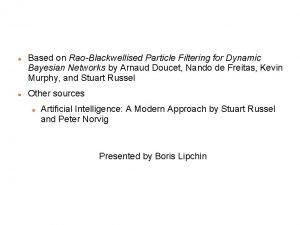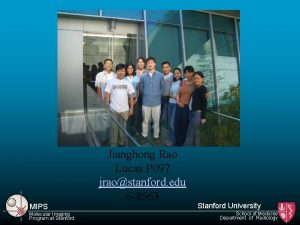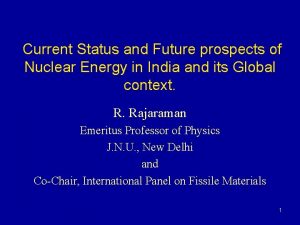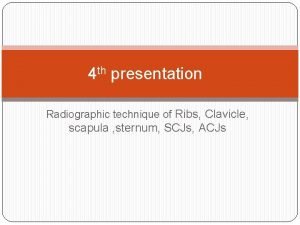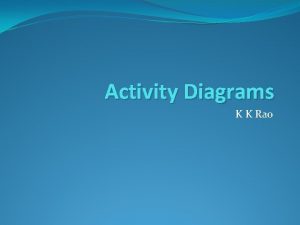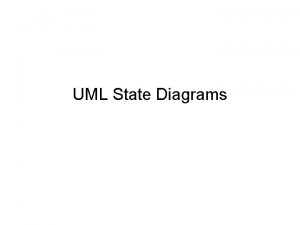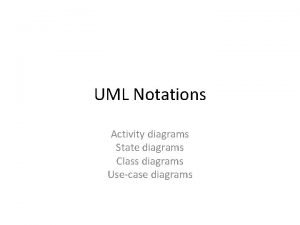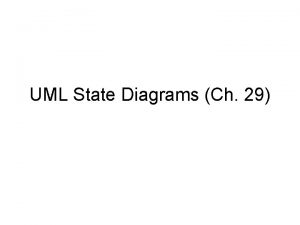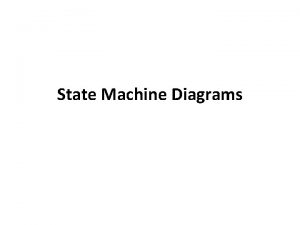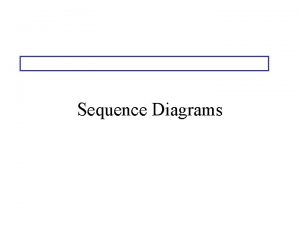State Diagrams K K RAO Definition State diagrams









- Slides: 9

State Diagrams K K RAO

Definition �State diagrams are one of the five diagrams in the UML for modeling the dynamic aspects of systems. A state diagram shows a state machine. �Both activity and state diagrams are useful in modeling the lifetime of an object. However, whereas an activity diagram shows flow of control from activity to activity across various objects, a state diagram shows flow of control from state to state within a single object. �State diagrams are not only important for modeling the dynamic aspects of a system, but also for constructing executable systems through forward and reverse engineering.

Fig � In the UML, you model the event-ordered behavior of an object by using state diagrams. As figure shows, a state diagram is simply a presentation of a state machine, emphasizing the flow of control from state to state. �

Concepts � A state diagram shows a state machine, emphasizing the flow of control from state to state. � A state machine is a behavior that specifies the sequences of states an object goes through during its lifetime in response to events, � A state is a condition or situation in the life of an object during which it satisfies some condition, performs some activity, or waits for some event. � An event is the specification of a significant occurrence that has a location in time and space � A transition is a relationship between two states indicating that an object in the first state will perform certain actions and enter the second state when a specified event occurs and specified conditions are satisfied. � An activity specifies an ongoing execution within a state machine. � An action specifies a primitive executable computation that results in a change in state of the model or the return of a value. Graphically, a state diagram is a collection of nodes and arcs.

Contents State diagrams commonly contain �Simple states and composite states �Transitions, events, and actions Common Uses 1. You use state diagrams to model the dynamic aspects of a system. These dynamic aspects may involve the event-ordered behavior of any kind of object in any view of a system's architecture, including classes (which includes active classes), interfaces, components, and nodes. 2. you'll typically use state diagrams to model reactive objects when u model the dynamic aspects of the system

Common Modeling techniques � Modeling Reactive Objects � Choose the context for the state machine, whether it is a class, a use case, or the system as a whole. � Choose the initial and final states for the object. � Decide on the stable states of the object by considering the conditions in which the object may exist for some identifiable period of time. Start with the high-level states of the object and only then consider its possible substates. � Decide on the meaningful partial ordering of stable states over the lifetime of the object. � Decide on the events that may trigger a transition from state to state. Model these events as triggers to transitions that move from one legal ordering of states to another. � Attach actions to these transitions (as in a Mealy machine) and/or to these states (as in a Moore machine). � Consider ways to simplify your machine by using substates, branches, forks, joins, and history states. � Check that all states are reachable under some combination of events. � Check that no state is a dead end from which no combination of events will transition the object out of that state. � Trace through the state machine, either manually or by using tools, to check it against expected sequences of events and their responses.

Contd. .

State Chart diagram {other way} �It is life cycle of single class

example





